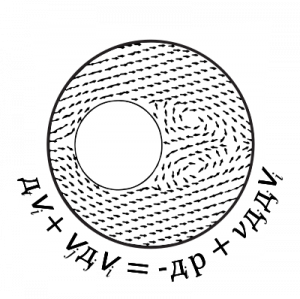Navier-Stokes equation
From Wikipedia, the free encyclopedia
In physics, the Navier–Stokes equations (/nævˈjeɪ stoʊks/), named after Claude-Louis Navier and George Gabriel Stokes, describe the motion of viscous fluid substances.
These balance equations arise from applying Isaac Newton's second law to fluid motion, together with the assumption that the stress in the fluid is the sum of a diffusing viscous term (proportional to the gradient of velocity) and a pressure term—hence describing viscous flow. The main difference between them and the simpler Euler equations for inviscid flow is that Navier–Stokes equations also factor in the Froude limit (no external field) and are not conservation equations, but rather a dissipative system, in the sense that they cannot be put into the quasilinear homogeneous form:
$$ {\mathbf {y} _{t}+\mathbf {A} (\mathbf {y} )\mathbf {y} _{x}=0.}{\displaystyle \mathbf {y} _{t}+\mathbf {A} (\mathbf {y} )\mathbf {y} _{x}=0.} $$
The Navier–Stokes equations are useful because they describe the physics of many phenomena of scientific and engineering interest. They may be used to model the weather, ocean currents, water flow in a pipe and air flow around a wing. The Navier–Stokes equations, in their full and simplified forms, help with the design of aircraft and cars, the study of blood flow, the design of power stations, the analysis of pollution, and many other things. Coupled with Maxwell's equations, they can be used to model and study magnetohydrodynamics.
The Navier–Stokes equations are also of great interest in a purely mathematical sense. Despite their wide range of practical uses, it has not yet been proven whether solutions always exist in three dimensions and, if they do exist, whether they are smooth – i.e. they are infinitely differentiable at all points in the domain. These are called the Navier–Stokes existence and smoothness problems. The Clay Mathematics Institute has called this one of the seven most important open problems in mathematics and has offered a US$1 million prize for a solution or a counterexample.

